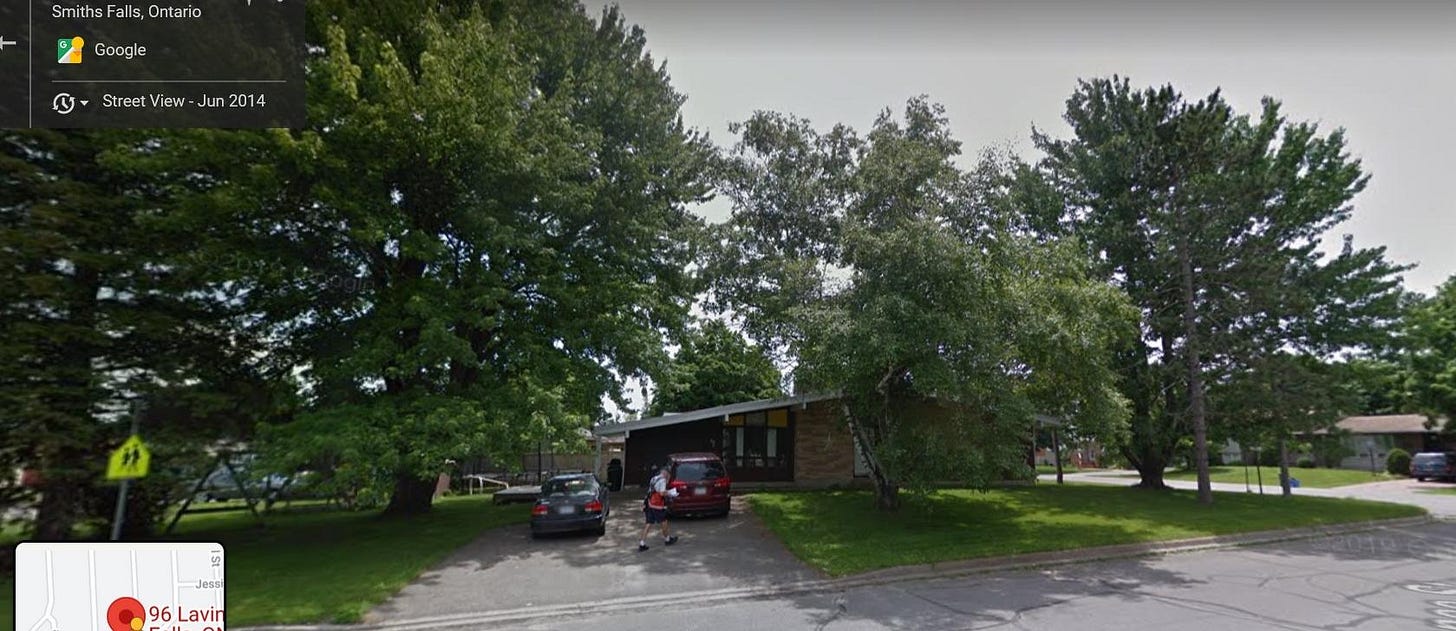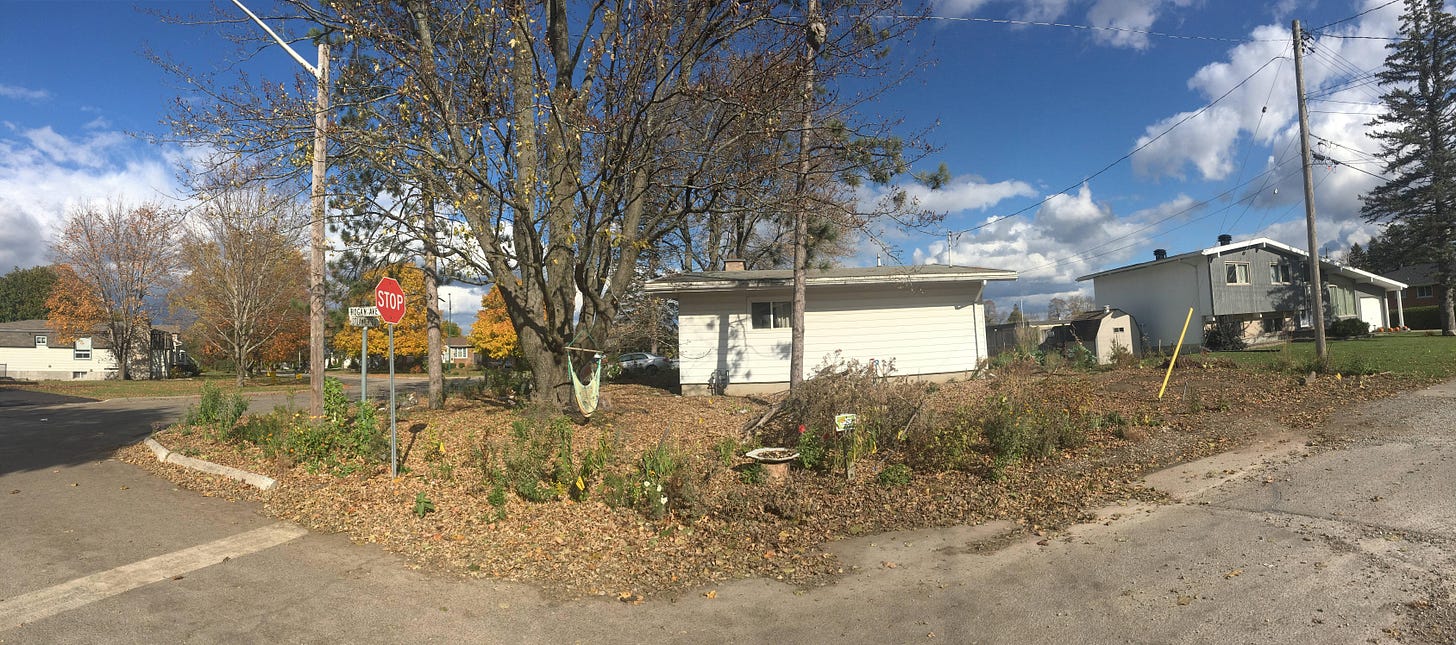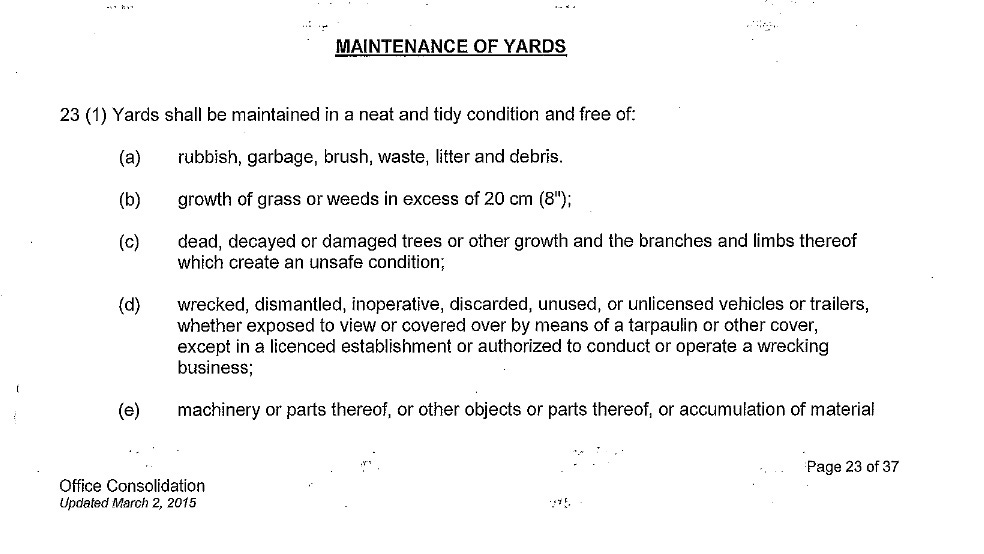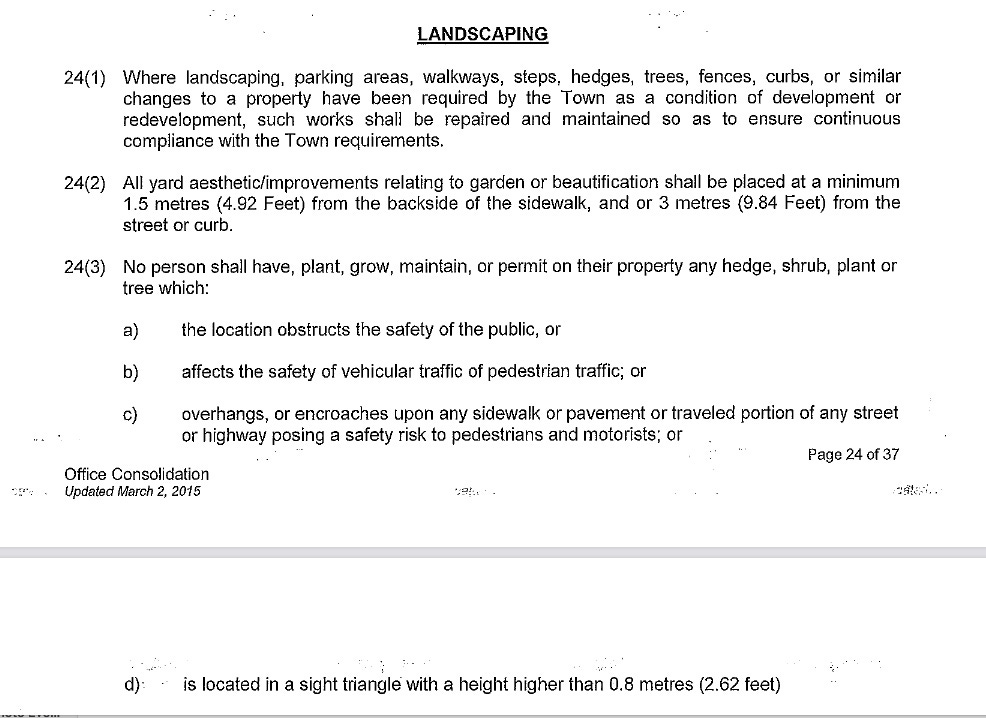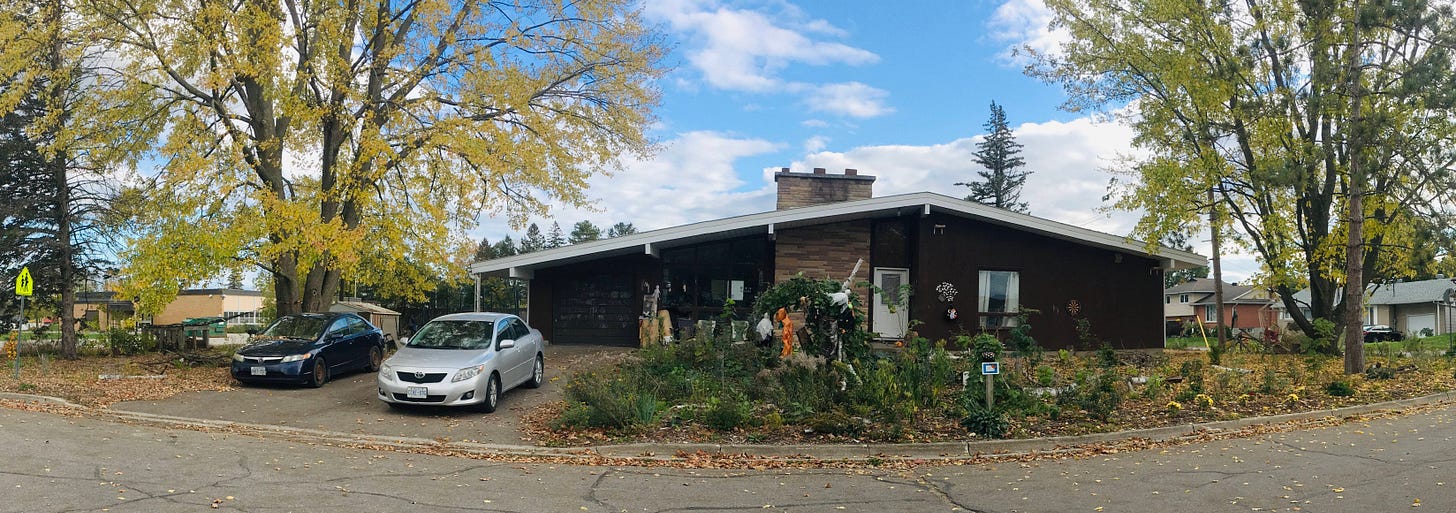Is the lawn still king or will city bylaws finally be modernized to protect our right to create a naturalized garden?
This is Craig and Beth Sinclair's story
It was like I had entered an alternate reality when I heard about the Sinclair’s fight to maintain the integrity of their native habitat and pollinator garden. But let’s back up a minute first.
Just a couple of days previous, I had watched an online lecture by New Yorker Kate Orff, a refreshingly ecologically-aware landscape architect who seeks to re-set damaged or lost ecosystems, thereby reconnecting people with nature and with each other. It was part of the 22nd Annual Winter Lecture Series put on by the New York Botanical Garden. Orff’s latest book, Toward an Urban Ecology, seeks to champion the idea of building with nature, not simply in it. Her lecture was entitled “Mending the Landscape” and in it she described several initiatives by her firm which included a $60 million dollar “living” breakwater project using man-made oyster reefs off the east and southern shores of Staten Island. It is a government project initiated after the coastline devastation caused by Superstorm Sandy in 2012 and seeks to re-establish the oyster colonies that once lived there, thereby protecting and reinvigorating the shoreline as well as the rich marine ecosystem that used to thrive and help rejuvenate a long-since-dead oyster farming industry. You can watch her in action in a Ted Talk here.
And although her design scope is large, she is in tune with the individual gardener as well, and their responsibility to help heal the earth’s ecology:
“Even though gardening is listed in the top five hobbies of Americans, somehow we’ve not translated that into care for our environment. We need to try to somehow do a better job of bridging the divide between personal gardens and the larger global situation. It’s all connected.”
So, when I came across a story on my Facebook feed of Craig and Beth Sinclair, a couple who live in the sleepy hamlet of less than ten thousand residents called Smith’s Falls, which is about an hour south-west of Ottawa, I was intrigued.
You see, the Sinclairs had removed the patchy, thirsty and struggling lawn on their small town corner property, and put down a thick layer of shredded wood mulch to create a hospitable start for new plants and young trees. Their plan was simple: make a garden that had a purpose that went beyond the ubiquitous lawn and foundation plantings that are the legacy of 20th century suburban gardening tradition. Instead of a monoculture, their front and side yards were to become a refuge for wildlife, including birds, bugs and butterflies, and in order to achieve this, they would use native perennials, ground covers, trees and shrubs. Their five paper birch trees succumbed to the ravages of the birch borer, but no need to panic, they cut the trunks into logs and placed them amongst the plants to act as “nurse” logs — that is, sections of tree trunk that would become decaying wood, attracting bacteria and fungi, insects, birds and other creatures, and over time producing a rich new soil called humus. They purchased whips (young trees) from the local Ferguson Tree Nursery and native plants where they could find them, as well as hard to find seed species from indigenous Ontario and Quebec seed providers, and they all began to find a home in their yard.
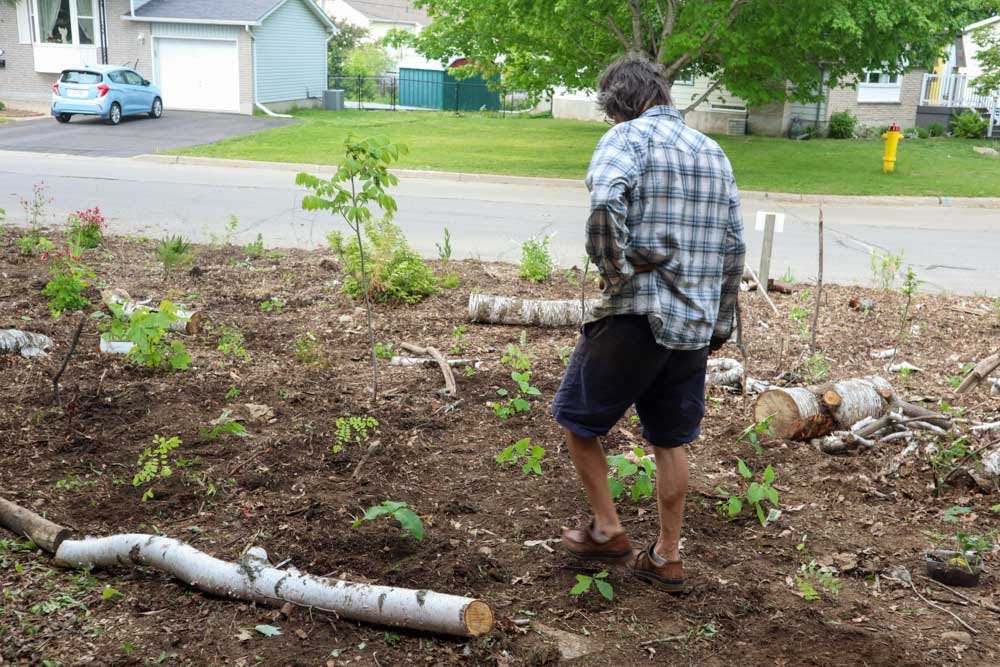
Craig Sinclair was spurred on to create this native plant pollinator garden after recognizing the devastation being caused in his own town (and well beyond) by the emerald ash borer. Hundreds of ash trees were being killed and with them, a decrease in their contribution toward shade, ecological habitat and oxygen production. He was galvanized to do something; so not only did he undertake to research and document his own town’s urban tree canopy and make suggestions about Smiths Falls urban forest to his local councillors and Mayor, but he did months of research to understand how to best create a natural habitat on his own property.
Fast forward and a twitchy neighbour had contacted Bylaw enforcement no less than ten times about the Sinclair’s developing garden, as he or she believed it contravened several ordinances. According to Craig Sinclair, they had been able to ward off the officers on previous occasions by having conversations with them about what they were trying to achieve and how their habitat garden, which was in its infancy, required a bit of a paradigm shift…not to mention that he was within his constitutional rights to express himself by having the garden of his choice AND that the bylaws were actually unconstitutional (more of this below).
But in the end, the Bylaw machine caught up with them. The resulting list of infractions included: the nurse logs being identified as debris or waste, the “weeds” and “grass” being over 20 centimetres tall, and there being “aesthetic planting” to within 9’ of the curb.
*************************************************************************************************************
Do you have any idea what your bylaws say that restrict the type of planting that you can carry out on your own property? Well, in Smith’s Falls, the property standards bylaw originates from 2003, with some updates from 2015. Here it is:
Upon reading this bylaw, you might be surprised to see how much of the language is subjective and allows for the attending officer to use his own discretion in deciding what is allowable and what is not. Some of the terms include: “neat and tidy”, “unsafe”, “not in keeping with the neighbouring properties”, “unsightly”, “debris” or “untidy”. I would hazard to guess from the Sinclair’s experience that if one doesn’t keep one’s property exactly like their neighbours, that is, with a regularly mowed lawn, all flowering plants or shrubs well within the perimeter of the property (i.e. against the house, or at least well away from the curb, sidewalk or walkways), you will quickly become a neighbourhood pariah.
You can watch the Smith’s Falls Property Standards hearing concerning the Sinclair’s case that was held in January 2022 here.
*************************************************************************************************************
The culture of the home lawn with its neat and tidy front yard plantings is long-standing. Since European settlers claimed this land as their own centuries ago (of course, they were in reality stealing it from those who already lived here…but that’s a story for another time), taming the landscape was at the top of their list. The wild was just that, wild, and it was human beings responsibility to keep it at bay and if possible, wrangle and domesticate it. Michael Pollan writes:
My house abuts woods on two sides, and mowing the lawn is, in both a real and metaphorical sense, how I keep the forest at bay and preserve my place in this landscape. Much as we’ve come to distrust it, the urge to dominate nature is a deeply human one, and lawn mowing answers to it. I thought of the lawn mower as civilization’s knife and my lawn as the hospitable plane it carved out of the wilderness. My lawn was a part of nature made fit for human habitation.
Pollan is one of my favourite authors, and he wrote a short treatise on the history of the American lawn in his book Second Nature: A Gardener’s Education. In it he explains that he learned from his father’s anarchistic attitude that lawn care was indeed a civic responsibility within the American suburb, and anyone who dared upset the continuity of the linking neighbourhood lawn-scape was nothing short of a rebel, an upstart, possibly even anti-democratic.
Pollan makes a reference to the 1881 instructional publication by Frank J. Scott entitled The Art of Beautifying Suburban Home Grounds of small extent. In it, we find the seeds of lawn love, which still exist today, over 140 years later:
A smooth, closely shaven surface of grass is by far the most essential element of beauty on the grounds of a suburban home. Dwellings…with rough uncarpeted floors, are no more incongruous, or in ruder taste, than the shrub and tree and flower-sprinkled yards of most home-grounds, where shrubs and flowers mingle in confusion with tall grass, or ill-defined borders of cultivated ground.
*************************************************************************************************************
There have been other gardeners before the Sinclairs who have battled the bylaws. In the late 1990s, Douglas Counter ran afoul of city hall when he re-claimed the city-owned ditch garden in front of his house in the Toronto suburb of Etobicoke and planted it with native perennials. Counter had confidence that his naturalized garden on his own property was protected as a result of the earlier landmark case between another Torontonian, Sandy Bell. That case saw Bell’s choice to garden with her conscience in a way that was different from her neighbours as her constitutionally protected right.
In his decision that upheld Bell’s right to garden naturally in her front yard, Ontario Justice Fairgrieve wrote:
There can be no doubt that the appellant's act of growing a naturalistic
garden that included tall grass and weeds had expressive content and conveyed
meaning. As an environmentalist, Ms. Bell implemented a landscaping form
intended to convey her sincerely held beliefs concerning the relationship
between man and nature. It also implicitly conveyed a critique of the prevailing
values reflected in conventional landscaping practices. She testified that she
meant to show her son, and presumably the public at large, that one could
co-exist with nature in a peaceful, nurturing way. In Ross v. School District
No. 15, supra at p. 865, La Forest J. repeated that "the unpopularity of the
views espoused" is not relevant to determining whether their expression falls
within the guarantee of freedom of expression. The fact that many people
evidently do not share the appellant's environmental beliefs and disapprove of
the way she chose to manifest them does not remove her chosen form of expression
from the protection of s. 2(b).
In ‘Garden of Controversy’, Episode 4 (2003) of the gardening series called Recreating Eden, Counter’s fight to keep his naturalized planting of the city-owned drainage ditch was chronicled. It is a fascinating story and well worth the time to watch.
So, are the tides shifting? Are there now more people who see the value in creating a garden that isn’t primarily lawn, and that encourages nature in all its messy, colourful, unruly, languorous and unpredictable glory?
These looser gardens, ones where the gardener might do the initial planting but then allows plants to meander, self-seed, fall into each other, sway in the breeze and not appear constrained in any way that are the ones where we, as viewers, must shift our thinking. The scale is larger with many of these plants, and the feeling as we experience them is that of being surrounded, enveloped and our own space challenged. For some, it may be a somewhat uncomfortable feeling; for others, one that reminds them of their childhood, where so many plants would tower above…
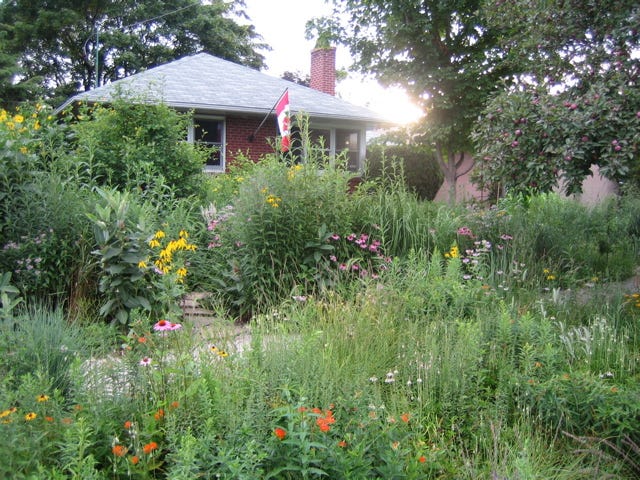
Douglas Counter’s garden in Toronto was one of many native wildflower gardens that pre-dated the Sinclairs and gives the viewer an idea of what a prairie garden using native plants can look like over time.
************************************************************************************************************
However, Craig Sinclair didn’t just want to create a naturalized pollinator garden, although that was an element to it. He had a bigger plan for his front and side garden.
“It has always been my intent that the garden and native food forest on the unceded land on which my house sits would be entirely restored to the condition that it was in when it was unfairly taken from the Algonquin and Anishinaabe nations that had maintained this land for thousands of years.” Craig Sinclair
He has used as inspiration the Miyawaki method of re-forestation, developed by the Japanese botanist Akira Miywaki in the 1980s. It is similar to the ideas of permaculture, whereby native trees and shrubs are planted densely and over a relatively short period of time, create a biologically diverse forest. Sinclair planted three trees in every square metre; he chose sugar maple, black cherry, bitternut hickory, northern catalpa and sumac. In the rear yard, he is concentrating on vegetables as well as an orchard which includes native plum, cherry, apple, plum, and pear trees as well as several native vines and shrubby berry plants. Sinclair calls it his '“Miyawaki food garden” and his intent is for it to be sustainable, require little maintenance in the way of mowing or spraying, and contribute toward the health of the planet but generating more oxygen, shade, food and habitat for all of nature’s creatures.
There are so many ironies to the Sinclair’s story:
the property standards bylaw under which they were cited is now under review;
early in 2021 the Smith’s Falls Tree Canopy and Vegetation Preservation and Enhancement Policy was drafted;
the property standards hearing was prefaced by a land acknowledgement statement;
two pollinator gardens were planted in downtown Smith’s Falls in the summer of 2021;
in 2022, the idea of creating a garden that is in sync with battling the effects of climate change, protecting pollinators, rejuvenating the soil, limiting the use of fossil fuels and chemicals, and restoring the native forest should be embraced by everyone.
So now the Sinclairs are taking the town of Smith’s Falls to court, where an Ontario Supreme Court justice will once again decide whether a homeowner can exercise their right to freely express themselves through their garden design and planting. Happily, the Sinclairs have a powerhouse team behind them: Lorraine Johnson (native plant she-ro and prolific writer on the subject), Nina-Marie Lister (Professor and Graduate Director, School of Urban Regional Planning and Director, Ecological Plant Lab at Ryerson University, Toronto) who fought her own native pollinator garden battle; and experienced environmental lawyer, David Donnelly.
If you care to, please consider contributing towards the Sinclair’s fight here.
I’ll be updating in a blog post in the future. Stay tuned.



